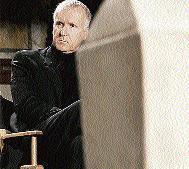
Filmmaker James Cameron listens at a news conference in New York, on Monday, as he sits behind one of two ossuaries said to have been found in a 2,000-year-old tomb in Talpiot, Jerusalem, in 1980, that may have held the bones of Jesus and Mary Magdalene. Cameron and documentary filmmaker Simka Jacobovici unveiled the artifacts in New York on Monday, to promote a documentary film which claims scientists may have found the lost tomb of Jesus Christ and that Jesus and Mary Magdalene may have had a son named Judah. - Reuters NEW YORK (Reuters):
Titanic director James Cameron presented on Monday what he said was evidence the tomb of Jesus had been uncovered, but some scholars dismissed it as a publicity stunt.
The Oscar-winning filmmaker and a team of scholars showed two stone ossuaries, or bone boxes, that he said might have once contained the bones of Jesus and Mary Magdalene. The findings are the subject of a documentary he produced called The Lost Tomb of Jesus and a book The Jesus Family Tomb.
The two small caskets were part of 10 found in 1980 during construction in South Jerusalem. Several had inscriptions translated as Jesus, Mary Magdalene and "Judah, son of Jesus," Cameron told a news conference at the New York Public Library surrounded by scholars and archaeologists.
"This is the beginnings of an ongoing investigation," Cameron said. "If things come to light that erode this investigation, then so be it."
Ire of Christians
The filmmakers said that statistically there was a one in 600 chance that the names found on the inscriptions were not the family of Jesus.
They also argued that the name 'Mariamene e Mara, the only inscription written in Greek, translated to Magdalene's real name.
If this was the tomb of Jesus, the revelations are likely to raise the ire of Christians because the discoverywould challenge the belief that Jesus was resurrected and ascended to heaven.
The documentary comes on the heels of the huge success of the novel The Da Vinci Code, which contends that Mary Magdalene had a child with Jesus.
But Dr. Shimon Gibson, one of the archaeologists who discovered the tomb, told Reuters at the news conference he had a "healthy scepticism" the tomb may have belonged to the family of Jesus.
In Jerusalem, the Israeli archaeologist who also carried out excavations at the tomb on behalf of the Israel Antiquities Authority, disputed the documentary's conclusions.
The archaeologist, Amos Kloner, said the 2,000-year-old cave contained coffins belonging to a Jewish family whose names were similar to those of Jesus and his relatives.
"I can say positively that I don't accept the identification (as) ... belonging to the family of Jesus in Jerusalem," Kloner told Reuters. "I don't accept that the family of Miriam and Yosef (Mary and Joseph), the parents of Jesus, had a family tomb in Jerusalem."
"They were a very poor family. They resided in Nazareth, they came to Bethlehem in order to have the birth done there - so I don't accept it, not historically, not archeologically," said Kloner, a professor in the Department of Land of Israel Studies and Archaeology at Bar-Ilan University near Tel Aviv.
After they were discovered, the bones were reburied according to Orthodox tradition, leaving just the boxes with inscriptions and human residue to be examined though DNA testing.
Professor L. Michael White, of the University of Texas, said he also doubted the claims were true.
"This is trying to sell documentaries," he said, adding a series of strict tests needed to be conducted before a bone box or inscription could be confirmed as ancient. "This is not archeologically sound, this is fanfare."

